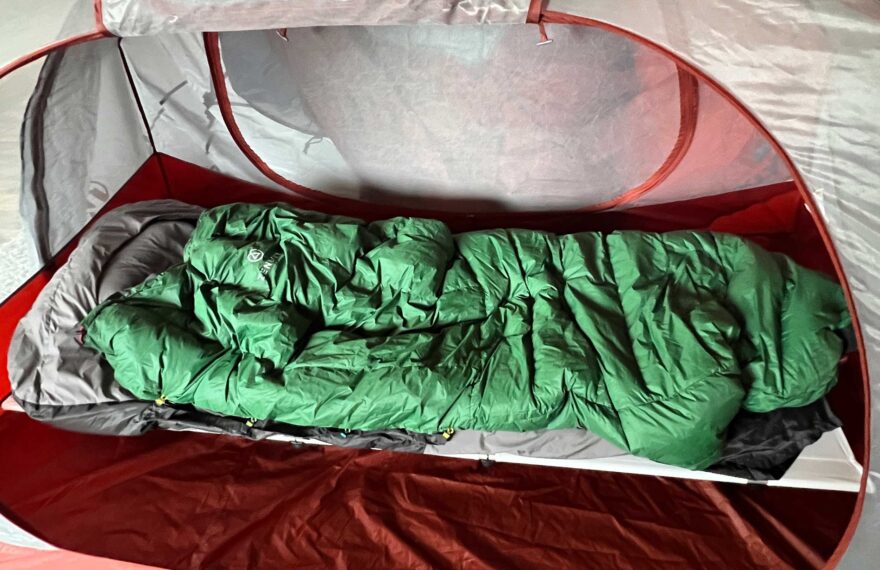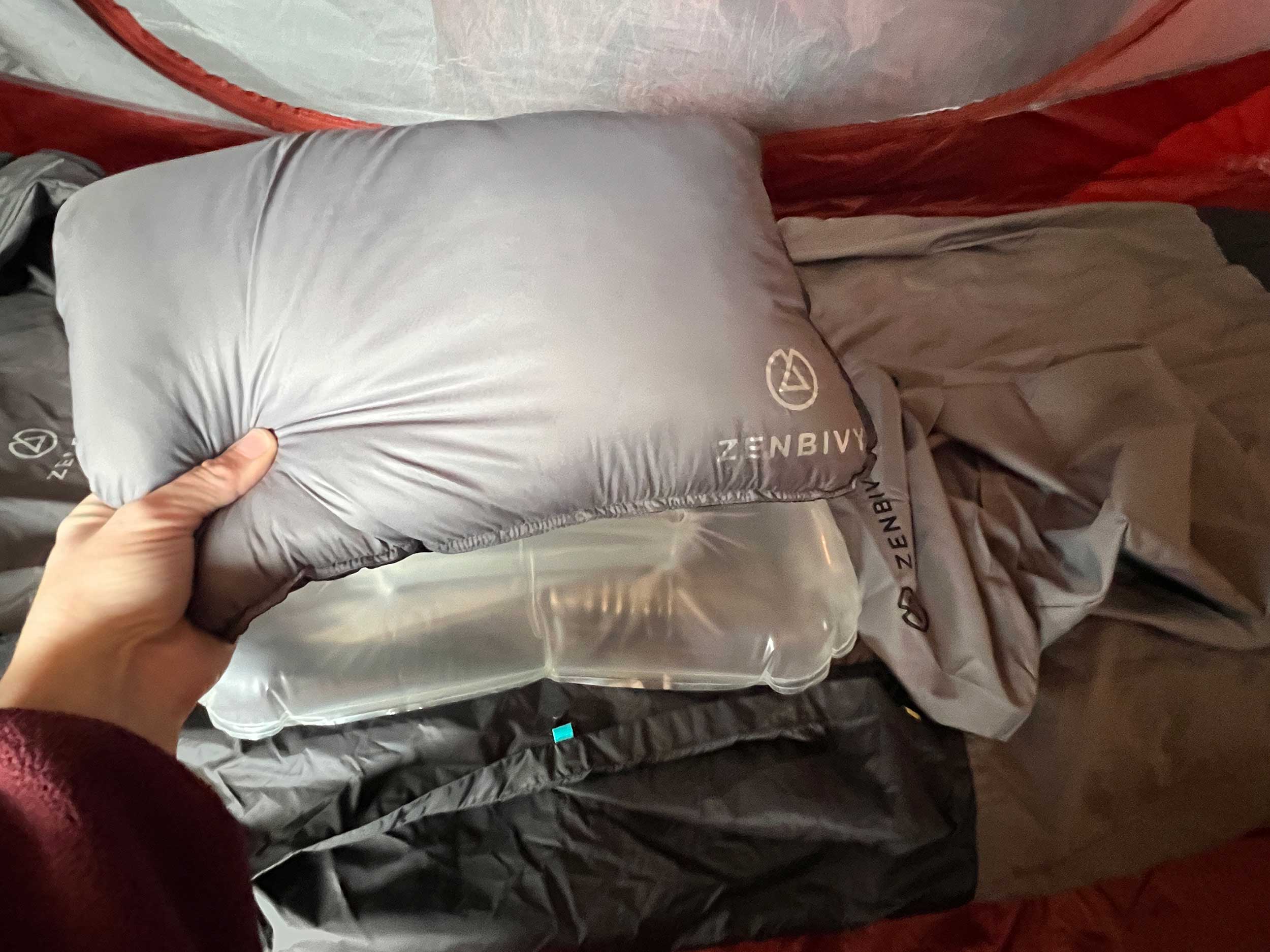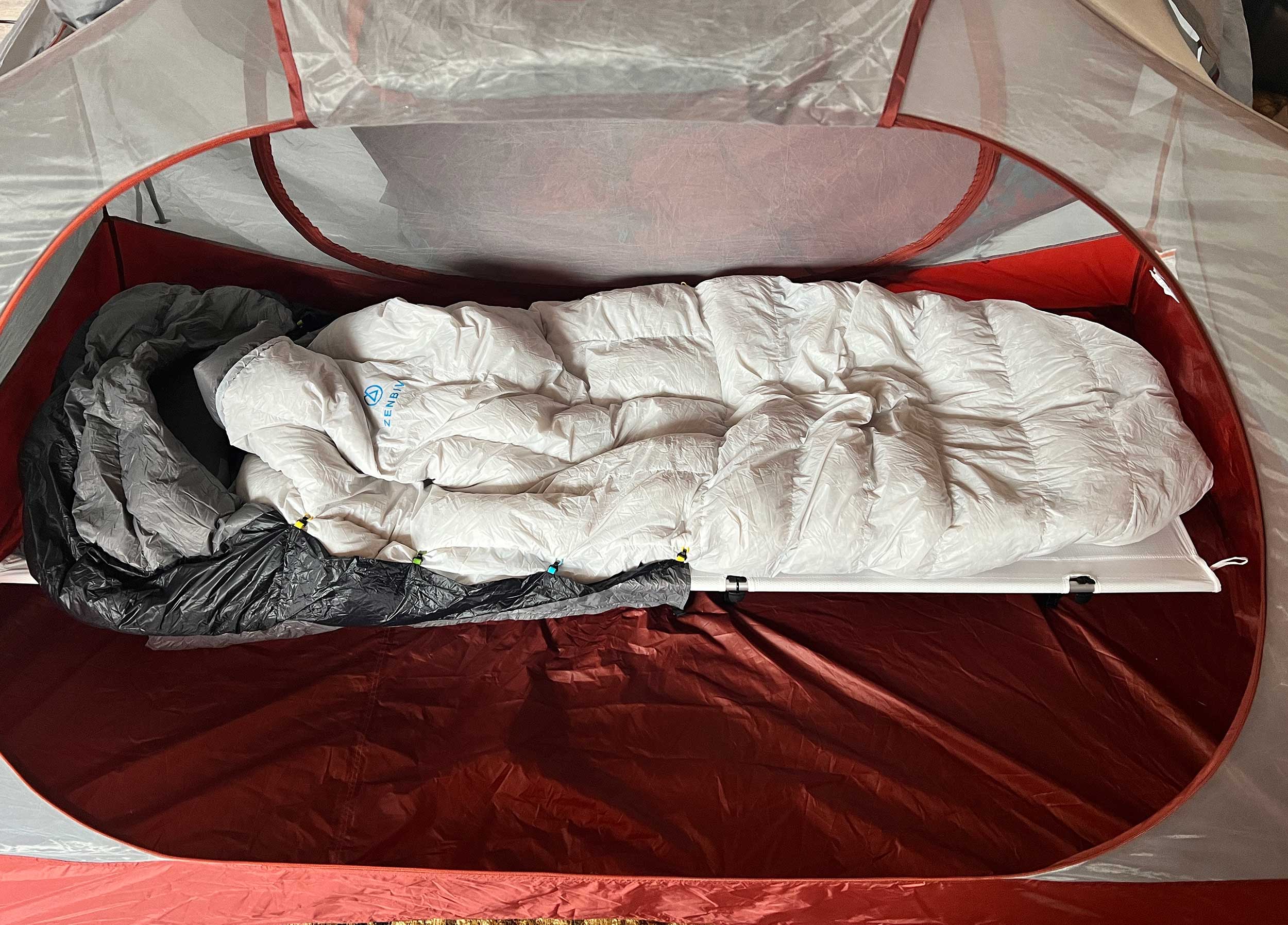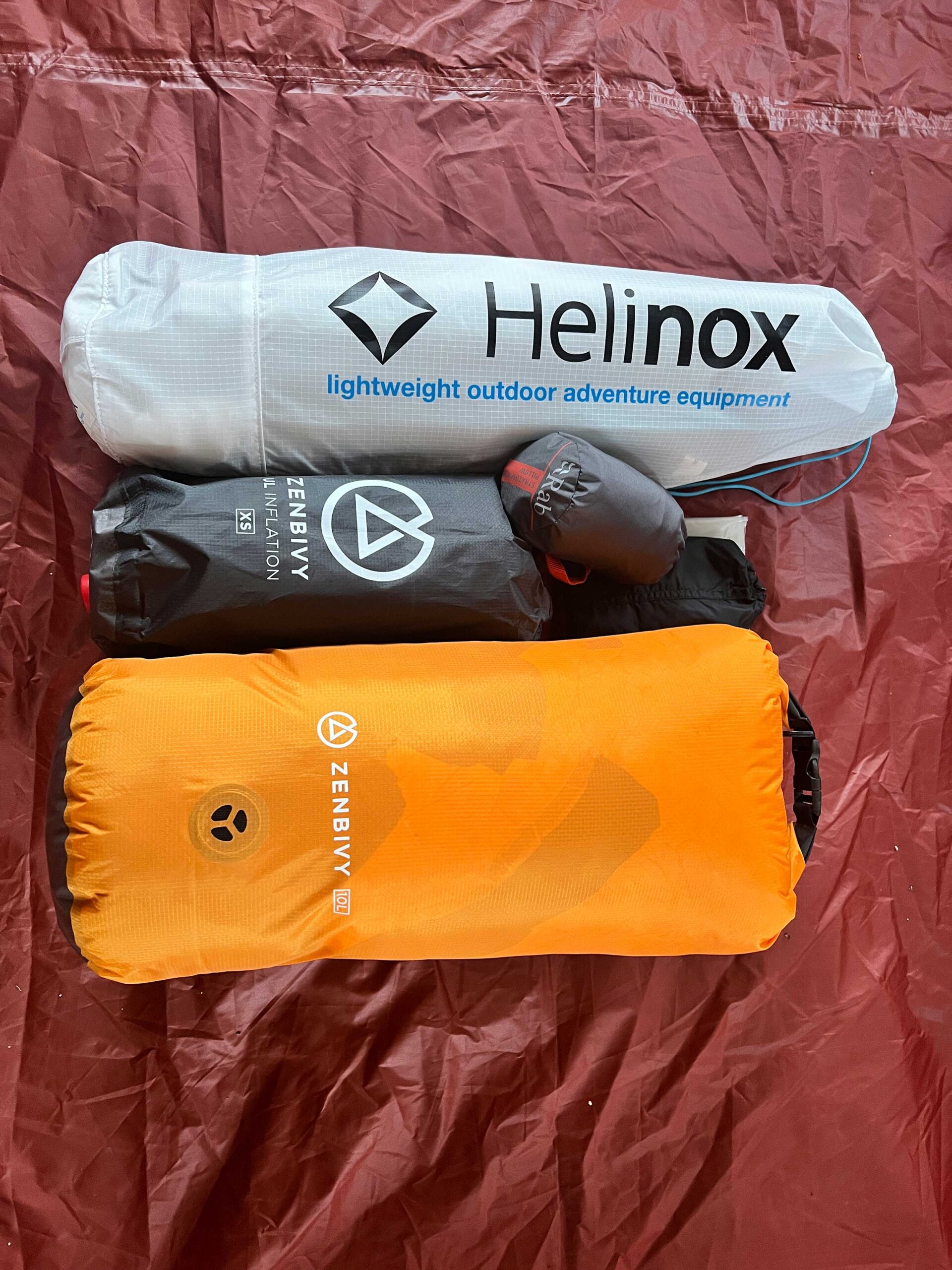
Zenbivy's Light Quilt, with a mattress and cot (Image by Suzanne Downing)
If you prioritize sleep in the backcountry over other comforts (like gourmet food and cooking gear), then you know how elusive a restful night can be when camping.
For short overnight or two-day backpacking trips, weight savings are important — but that doesn’t mean you have to sacrifice comfort. With some basic backcountry knowledge, a bit of extra planning and the right combination of gear, you can create a cozy sleep system that feels like you’re floating on a cloud. And, it’s a sleep system light enough to carry. Here are some tips for sleeping cozy in the backcountry.
1.Choose Your Campsite Wisely
When you’re ready to set up camp, look for a flat, sheltered spot away from strong winds, running water and rocky terrain. You should avoid low-lying areas where cold air settles at night, and check for overhead hazards like dead branches. Uneven ground can make sleeping uncomfortable, causing you to slide downhill or wake up sore. Camping too close to water may expose you to unexpected flooding or an increase in mosquitoes. And sleeping under dead branches is risky. If you take the time to be intentional about where you’ll be sleeping, you’re on your way to undisturbed sleep.

Image by Dmitry Kuksin, Shutterstock
2. Establish a Wind-Down Routine
Just like at home, a calming bedtime routine can help signal to your body that it’s time to sleep. Stretching, light reading, or listening to nature sounds can help you relax. Avoid looking at bright lights (like phone screens) right before bed to prevent disrupting your natural sleep cycle. Maybe take time to refuel and rehydrate, cook a warm, high-protein meal (like instant rice with tuna and hot sauce) and sip on an electrolyte drink. Another tip is to swap out your hiking clothes for dry base layers, fresh socks and a beanie to stay warm overnight. Being intentional about relaxing can really help aid in your sleep.
3. Have the Right Combination of Comfy Gear for You
When it comes to sleep in the backcountry, everyone has their own priorities. If you’re a side sleeper, you may focus on getting a plush, high-R-value sleeping pad that provides extra cushioning for your hips and shoulders, along with a fluffy down sleeping bag or quilt for maximum warmth. If you prefer less padding, but want to be elevated off the ground, you might opt for a lightweight backpacking hammock or cot, complete with an underquilt or sheet and down top quilt to trap heat while keeping off cold. If you’re a minimalist ultralighter, you may prioritize shedding weight by choosing an ultralight quilt and sheet over a traditional sleeping bag — a little less cushion in exchange for efficiency. Whether it’s warmth, comfort, or packability, tailoring sleep gear to your individual needs makes all the difference in backcountry rest.

Image by Suzanne Downing
The ultimate cozy backcountry sleep setup (great for side sleepers), is a plush elevated bed you can sink into after a day of hiking. Here’s one recommendation that’s become my favorite here in my home state of Montana as a side sleeper myself. All together it weighs in just under 7 pounds packed. (Yes, it’s on the heavier side for more than a night or two, but worth it if you prioritize a plush sleeping experience.)
- Helinox Lite Cot (2 lbs 12 oz packed, supports up to 265 lbs)
- Zenbivy Ultralight Tapered Mattress (1.1 lbs 20” x 72”) (Tip: The tapered fits best with the Helinox cot and has an R-value of 4.8)
- Zenbivy Light Quilt (25-degree down) (1.6 lbs) (So soft!)
- Zenbivy Light Full Sheet (25-degree down) (9 oz)(Also soft!)
- Zenbivy pillow stacking system with:
- Ultralight Pillow Case (1 oz)
- Pillow Air Bladder (1.4 oz)
- Down Pillow Topper (3.5 oz) (Dreamy!)
For me, this setup is the definition of backcountry luxury. The Helinox Lite Cot lifts you off the ground, eliminating cold spots and dampness while offering excellent back support. When you sleep on the ground, your sleeping pad/mattress has to block the cold ground from pulling away your body heat. A cot eliminates this issue by keeping you suspended in air. The Zenbivy Ultralight Mattress adds a soft, adjustable layer of cushioning, so you’re not dealing with uncomfortable pressure points. Topping it off is the Zenbivy Light Down Quilt and Full Sheet, which combine ultra-soft fabrics, a premium down insulation that offers superior loft and stability while compressing down efficiently into a dry bag. Tip: If you’re not a side sleeper and don’t need the plush air mattress or the extra warmth, you can drop a pound by taking away the air mattress.

Image by Suzanne Downing
Another cozy backcountry sleep system that’s less weight is a combination of some of the same gear in an ultimate cozy sleep set up — minus the cot and pillow stacking combo. This set up weighs under 3 lbs.
- Zenbivy Ultralight Tapered Mattress (1 lbs. 1 oz. 20” x 72”) (Tip: The tapered fits best with the Helinox cot and has an R-value of 4.8)
- Rab Stratosphere Inflatable Pillow (3.35 oz.) (Small, plush and cozy all-in-one option)
- Zenbivy Ultralight Quilt 25 degree Muscovy Down (1 lbs.1 oz.) (So fluffy and soft!)
- Zenbivy Ultralight Sheet 25 degree Muscovy Down (3 oz.)
Not everyone needs the full “floating-on-a-cloud” experience. Depending on your pack weight preferences and how much comfort you require, you can mix and match components to build a sleep system tailored to you.
4. Minimize Noises and Disruptions
If you’re a light sleeper, bring earplugs or use natural white noise like rustling leaves or a flowing stream to mask disturbances. Let your body adjust to nature’s rhythm, and if needed, practice breathing exercises to help you drift off despite unfamiliar sounds.

Image by Suzanne Downing
After hiking all day, your body craves deep, restorative sleep. A poor night’s rest can leave you sluggish, sore and unmotivated the next morning. But with the right sleep system and smart camping habits, you can actually wake up rejuvenated and ready to tackle your adventure.
Whether you go for the full cloud-like setup or a more minimalist approach, prioritizing quality sleep gear and good sleep habits ensures your backcountry experience is enjoyable from start to finish. No need to compromise comfort for weight — find the balance that works for you.
Suzanne Downing is an outdoor writer and photographer in Montana with an environmental science journalism background. Her work can be found in Outdoors Unlimited, Bugle Magazine, Missoulian, Byline Magazine, Communique, MTPR online, UM Native News, National Wildlife Federation campaigns and more.

 Your Privacy Choices
Your Privacy Choices